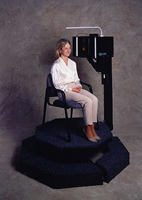
What every Humanities Computing center needs – the ability to scan humans. See Cyberware Products. I rather like the desktop model, but the scans don’t look that impressive.
Category: Playful or Cool
World’s Strangest Online Museums
I have long loved obscure museums, and so I was thrilled to discover a site dedicated to Unusual Museums of the Internet.
My favorite (so far) is FUNOMENA: WEIRD AND STRANGE MOBILE MUSEUM – one of the world’s smallest traveling exhibits. Another is the The Zymoglyphic Museum which I wouldn’t dare describe. Others will care more for toilet related museums, but there are toilets everywhere.
Creative Science Fiction
So a student at MIT and his friends are slipping invitations into books for future people to come back to our time for a time-travel party. Will anyone show up? How would we know if the person had really come from our future?
See Student organizes time-travel conference, Friday May 6, 2005 – From Associated Press.
Make: A Suitcase PC
A suitcase computer? Neat. See www.chriskaufmann.com/suitcase/.
This from the Make:Blog.
User 83211

Now what’s so special about being number 83211?
Digital Badges
I’ve been fascinated by the idea of wearable digital badges that could be programmed with messages. There are some affordable packages like the MessageTag or Mtag. The question (before I buy one) is … just what would I program it to display?
A related, but more sophisticated, product is nTAG which is essentially a small screen others can read off your chest. It has RFID and infrared so nTAGs can communicate with each other (“Hi, I like vanilla ice cream too!”) or with a central server. The nTAG web site is coy about privacy and costs. I think they rent you the service and don’t sell the technology, which is a pity, as it would be interesting to imagine some playful uses. For a story about nTAG, see Breaking the Ice 2.0.
Mindmapping: MyMind 1.2
MyMind by Sebastian Krau? is a Mac OS X freeware mindmapping tool. See also MyMind 1.2 – MacUpdate for details and to download. This is another mindmapping package for the list I blogged ealier – see More on Mindmapping. This is thanks to James Chartrand.
QR Codes

James, a graduate of our Multimedia program who is working in Japan came by for a visit and showed me his cell phone and the cool things it can do. Besides controlling things like a Karioke player with the IR port and being an MP3 player, it can scan QR Codes which are two-dimensional barcodes. The barcodes are showing up all over – in magazines to provide a coupon or a URL, on business cards so that you can scan in a person’s contact information, and on screens. The scanning software lets you scan multiple 2D barcodes and then can merge the data into one file so you can suck up little programs for your phone. Above all it seems quite robust – both the QR Code system and, for that matter, the regular OCR with the camera that lets you scan English text.
If you want to try it, this QR Code Generator lets you generate the barcodes. The code above is my contact information encoded for the Vodafone scanner. For more on QR Code see QR Code features or qrcode.com. According to their site, there is no licensing fee to use QR Codes, which may explain why it is taking off.
Continue reading QR Codes
Theremin: Theremax
Matt Patey pointed me to a cheaper source of Theremin kits. See PAiA: Theremax theremin, the kit costs $79 USD + shipping. Now I need to come up with a reason why I need this for multimedia research.
Biomotion Lab
St?©fan Sinclair drew my attention to a neat interactive visualization of walking, BioMotionLab1.6 by the Biomotion Lab at Ruhr-University and Queen’s University. It took me a bit to get it. Try it out.